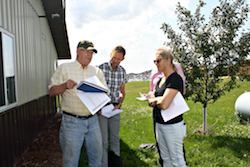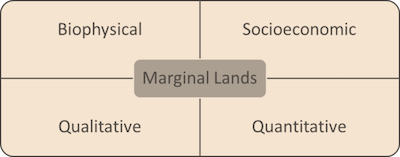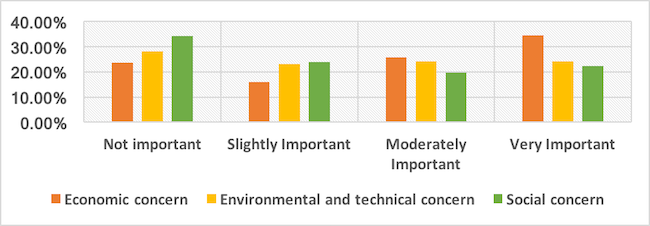NEWBio research discovers social, cultural, and economic motives behind local bioenergy decisions.

Landowner and other stakeholder responses to bioenergy crop production play a critical role in the bioenergy industry’s future. NEWBio’s Human Systems Team set out to understand the social, cultural, and economic factors that drive decisions about bioenergy development in the Northeast U.S. Drawing from social science disciplines, the team found evidence that social-cultural and economic factors of bioenergy crops, as well as interactions across experts and the public, play important roles in shaping land manager and other stakeholder responses to the local production of bioenergy crops and industry development.
Led by Weston Eaton and Michael Jacobson of Penn State, the team members, from a wide range of backgrounds, asked: what are the social, cultural, and economic barriers to bioenergy crop production and processing? Can different interactions between experts and stakeholders help overcome those hurdles? How do economic and business factors influence bioenergy decisions?

Funded by AFRI. Learn More.
Contents
- Differing Understandings of Bioenergy amongst Land Managers
- Land Manager Motivations and Bioenergy Expert Expectations
- Economics of Growing Energy Crops on Marginal Lands
- How Land Managers Make Land-Use Decisions About Marginal Lands
- Publications:
- NEWBio Human Systems Team
- Authors
Differing Understandings of Bioenergy amongst Land Managers
The team surveyed and interviewed landowners and other members of the public in the Northeast to identify socio-cultural factors that contribute to support for local bioenergy development and willingness to plant bioenergy crops. They uncovered two contrasting perspectives, leading the way to improved materials and activities that are appropriate for both bioenergy progressives and skeptics:
“Technology progressive” land managers view bioenergy crop technologies as innovative and in harmony with nature, and tend to be more supportive of, and willing to adopt, these technologies. These land managers are likely to respond to traditional outreach approaches that offer scientific information, such as fact sheets and demonstration sites.
“Technology skeptic” land managers believe bioenergy crop technologies are risky and conflict with natural processes; they tend to be less likely to support and less willing to adopt them. These land managers respond better to dialogue-based approaches to engagement that invite input from across a range of perspectives.
Accomplishments
- Improved understanding of how land manager attitudes influence participation in bioenergy production has elevated discussion and dialogue across the farm, business, policy, education, and research communities.
- Developed materials and activities appropriate for reaching landowners with contrasting perspectives, and disseminated them across the region.
Land Manager Motivations and Bioenergy Expert Expectations
The expectations of bioenergy experts (including scientists and policy experts) shape how land managers and other stakeholders respond to bioenergy crop development. Team members interviewed experts and found two central implicit assumptions:
- People will behave differently when they receive new facts and information. This assumption underlies outreach and engagement with members of the public on bioenergy crops, the aim of which is to provide information.
However, team research suggests that information provision alone does not typically change behavior. Bioenergy outreach programs more effectively foster agreement on what can and should be done with local bioenergy development when experts and prospective landowners exchange views and ideas as equals and use technical data to encourage rather than direct discussions.
- Land manager decisions about adopting bioenergy crops are motivated primarily by the potential to make a profit.
However, land managers also weigh bioenergy crops in light of their management goals, the legacy of land use in the region, and past experiences with developers and university experts. Along with promoting a profitable new enterprise, bioenergy advocates should also seek ways to enhance existing goals and livelihoods. Doing so will require a better understanding of how land managers make sense of their land, community, and bioenergy crop technologies.
One important factor influencing land managers’ support for bioenergy development is the ‘symbolic fit’ they perceive between locality and bioenergy crops. For example, the team found that land managers who view their land as needing protection and see bioenergy crop production as in harmony with natural processes, are more likely to support bioenergy crop development.
Accomplishments
- Identified effective ways to use scientific information and address barriers to stakeholder engagement; incorporating them into the design of education and outreach materials.
- Discovered that engagement with public groups on bioenergy development should aim to uncover the symbolic meanings that are important in particular localities, and incorporate these into technological design and implementation. In this way, project promoters can better address local concerns and empower local people to influence bioenergy development.
- Developed and piloted an improved approach to stakeholder engagement through dialogue and the mutual exchange of information, in contrast to traditional one-way flows of expert information.
- Showed that building stakeholder agreement about local bioenergy development requires the incorporation of local actors’ socio-cultural understandings, as well as economic motivations, into planning and public engagement.
Economics of Growing Energy Crops on Marginal Lands

Marginal lands are abundant in the Northeast, and growing bioenergy crops on them avoids competition with food crops, generates additional income for farmers, and provides multiple environmental benefits.
The team focused on identifying the socio-economic factors which influence landowner interest, and on prices at which landowners would be willing to grow energy crops on marginal lands. This information will help farmers in deciding whether to grow energy crops and in the development of public policy that encourages bioenergy development.
The team calculated and compared the break-even prices of energy crops and food crops, and found that switchgrass is the best crop choice for marginal lands in the study area, based on its lowest break-even price. The marginal soils that were studied were all economically suitable for energy crops, showing a favorable break-even analysis in these conditions when compared with corn.
The break-even price analysis focused only on the monetary value of energy crops, ignoring the value of environmental externalities such as protecting soil, water, and air quality; carbon sequestration, creation of wildlife habitat, and increased landscape diversity. If payment for these ecosystem services becomes available, growing energy crops will become more profitable and their commercial production more likely.
Accomplishments
- Refined the definition of marginal land for growing energy crops using a traditional economic approach.
- Identified where marginal lands are located, allowing companies and regional planners to target counties and regions with greater potential for bioenergy development.
- Assessed production costs and profitability of growing energy crops on different types of marginal land, including droughty soils, streamside buffers, and abandoned mine lands.
How Land Managers Make Land-Use Decisions About Marginal Lands
The team surveyed land managers in three Northeast states to better understand their decisions. By integrating biophysical and socioeconomic factors such as land management goals in their study, the team identified a range of factors which influence how land managers and farmers think about using marginal lands, and their interest in growing energy crops.
Economic concerns, primarily the unpredictability of future crop market and profitability, are the most important reasons leading land managers to require a high willingness-to-accept (WTA) price for supplying energy crops. These uncertainties may relate to higher energy crop costs than today’s market will bear, one of the barriers that must be overcome in developing a viable U.S. biofuel market.

Key findings from the survey:
- Price gaps exist in the cellulosic biofuel supply chain between researchers’ break-even analysis, what land managers will accept, and what industry will pay.
- The break-even price to produce energy crops was much lower than the WTA price. This suggests factors beyond direct price are important for all bioenergy stakeholders to consider.
- Land managers are more likely to supply energy crops and require a lower WTA price from marginal lands than from better agricultural land. However, the overall WTA price is still higher than the price that biofuel producers are likely to offer.
- Switchgrass is the energy crop that land managers are most familiar with and likely to adopt, while miscanthus and willow are relatively novel to them.
- Conservation and other amenity uses can compete with energy crop production for marginal lands. This suggests that promoting the ecosystem service benefits generated by energy crops, such as conservation and wildlife habitat, may be useful to bring the marginal land into energy crop production.
- Land manager perceptions are as important as the lands’ biophysical properties in how they define lands as marginal.
Accomplishments
- Improved understanding of the nature and impact of economic incentives in policies and programs to encourage deployment of bioenergy crops on economically marginal and environmentally suitable sites.
- Provided insights into local economic and social issues affecting future bioenergy development that are being used by community and regional planners.
- Enhanced understanding of the factors behind landowners’ willingness to grow energy crops and acceptable biomass prices is informing business and policy decisions.
- Provided key data for industry leaders and government agencies to evaluate ecosystem service payments and other novel financing strategies which will support bioenergy crop production.
Case Study – Will Brandeu grows, uses and sells warm-season grasses on his Pennsylvania farm. He discusses how he got started, how his operation works, and some of the applications of switchgrass:
Publications by the NEWBio Harvest, Preprocessing, and Logistics Team
For all NEWBio Project information, see the index: Resources from NEWBio: The Northeast Woody/Warm-season Biomass Consortium
Journal Publications, Fact Sheets and Case Studies, Research Summaries, White Papers, Webinars
Journal Publications
- News Media Analysis of Carbon Capture and Storage and Biomass: Perceptions and Possibilities. Feldpausch-Parker, A. M., Burnham, M., Melnik, M., Callaghan, M. L., Selfa, T. Energies, 2015, 8(4), 3058-3074. DOI: 10.3390/en8043058
- The politics of imaginaries and bioenergy sub-niches in the emerging Northeast U.S. bioenergy economy. Burnham, Morey, Weston M. Eaton, Theresa Selfa, Clare Hinrichs, & Andrea Feldpausch-Parker. 2017. Geoforum 82:66-76. DOI: 10.1016/j.geoforum.2017.03.022
- Bioenergy experts and their imagined “obligatory publics” in the United States: Implications for public engagement and participation. Eaton, Weston M., Morey Burnham, Clare Hinrichs, & Theresa Selfa. 2017. Energy Research & Social Science 25:65-75. DOI: 10.1016/j.erss.2016.12.003
Fact Sheets and Case Studies
- NEWBio Commercial Collaborators: Building a Sustainable Energy Future in the Northeast United States
- BCAP Helps Commercialize Shrub Willow for Bioenergy in Northern New York – Volk
- Market Analysis for Biomass Growers: Example Analyses of the Wood Chips and Paperboard Manufacturing Industries as Biomass Markets – Ruamsook and Thomchick
Research Summaries
- Biomass Crop Production May Benefit from a Wide Spectrum of Marketing Opportunities – Ruamsook and Thomchick
- How Bioenergy Experts Can Improve Public Engagement – Eaton
- Socio-cultural Factors Shape Landowner Support and Willingness to Adopt Bioenergy Crops – Eaton
White Papers
- Market Opportunities for Lignocellulosic Biomass: Analysis of Industry the Paperboard in The United States – Ruamsook and Thomchick
- Market Opportunity For Lignocellulosic Biomass. Background Paper: Multi-tier Market Reference Framework – Ruamsook and Thomchick
NEWBio Human Systems Team
Penn State specialists Weston Eaton, Natural Resource Sociologist and Michael Jacobson, Professor of Forest Resources, led the team:
- Saurabh Bansal, Patrick Boleman, Clare Hinrichs, Wei Jiang, Kusumal Ruamsook, Evelyn Thomchick, Wei Jiang and Katherine Zipp – Penn State University
- Andrea Feldpausch-Parker and Theresa Selfa – SUNY-ESF
- Matt Langholtz – Oak Ridge National Laboratory
- Morey Burnham – Idaho State University
Authors
- Weston M. Eaton, Research Associate, Agricultural Economics, Sociology, and Education, Penn State University
- Michael Jacobson, Professor of Forest Resources, Penn State University
- Wei Jiang, Research Assistant, Penn State University
- Katherine Zipp, Assistant Professor of Environmental and Resource Economics , Penn State University
- Susan J. Harlow, Freelance Journalist
 The Northeast Woody/Warm-season Biomass Consortium – NEWBio is supported by the Agriculture and Food Research Initiative. This material is based upon work that is supported by the National Institute of Food and Agriculture, U.S. Department of Agriculture, under award number 2012-68005-19703.
The Northeast Woody/Warm-season Biomass Consortium – NEWBio is supported by the Agriculture and Food Research Initiative. This material is based upon work that is supported by the National Institute of Food and Agriculture, U.S. Department of Agriculture, under award number 2012-68005-19703.
Led by Penn State University, NEWBio includes partners from Cornell University, SUNY College of Environmental Science and Forestry, West Virginia University, Delaware State University, Ohio State University, Rutgers University,  USDA’s Eastern Regional Research Center, and DOE’s Oak Ridge National Laboratory and Idaho National Laboratory.
USDA’s Eastern Regional Research Center, and DOE’s Oak Ridge National Laboratory and Idaho National Laboratory.
